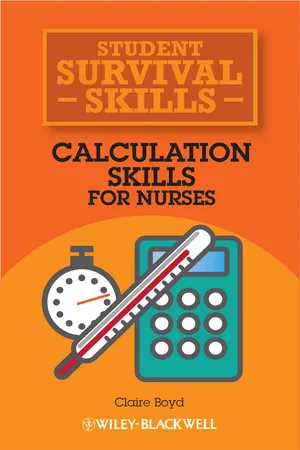
- English
- ePUB (mobile friendly)
- Available on iOS & Android
eBook - ePub
Calculation Skills for Nurses
About this book
Providing nursing students with words of wisdom and advice from real-life student nurses, Calculation Skills for Nurses enables you to calculate drug dosages with ease, boosting your confidence and competence in this core area of nursing practice. The book takes away the fear of calculations, making it approachable, easy and fun, and ties in with the NMC standards for pre-registration education and the Essential Skills Clusters. It is filled with examples and questions based on real life nursing and healthcare situations and includes key information displayed on the inside back cover for quick look-up on clinical placements.
Frequently asked questions
Yes, you can cancel anytime from the Subscription tab in your account settings on the Perlego website. Your subscription will stay active until the end of your current billing period. Learn how to cancel your subscription.
No, books cannot be downloaded as external files, such as PDFs, for use outside of Perlego. However, you can download books within the Perlego app for offline reading on mobile or tablet. Learn more here.
Perlego offers two plans: Essential and Complete
- Essential is ideal for learners and professionals who enjoy exploring a wide range of subjects. Access the Essential Library with 800,000+ trusted titles and best-sellers across business, personal growth, and the humanities. Includes unlimited reading time and Standard Read Aloud voice.
- Complete: Perfect for advanced learners and researchers needing full, unrestricted access. Unlock 1.4M+ books across hundreds of subjects, including academic and specialized titles. The Complete Plan also includes advanced features like Premium Read Aloud and Research Assistant.
We are an online textbook subscription service, where you can get access to an entire online library for less than the price of a single book per month. With over 1 million books across 1000+ topics, we’ve got you covered! Learn more here.
Look out for the read-aloud symbol on your next book to see if you can listen to it. The read-aloud tool reads text aloud for you, highlighting the text as it is being read. You can pause it, speed it up and slow it down. Learn more here.
Yes! You can use the Perlego app on both iOS or Android devices to read anytime, anywhere — even offline. Perfect for commutes or when you’re on the go.
Please note we cannot support devices running on iOS 13 and Android 7 or earlier. Learn more about using the app.
Please note we cannot support devices running on iOS 13 and Android 7 or earlier. Learn more about using the app.
Yes, you can access Calculation Skills for Nurses by Claire Boyd in PDF and/or ePUB format, as well as other popular books in Medicine & Nursing Skills. We have over one million books available in our catalogue for you to explore.
Information
Part 1
DIAGNOSIS
Chapter 1
CALCULATIONS REVISION
LEARNING OUTCOMES
By the end of this chapter you will have familiarised yourself with the basics of decimals, metric measures, percentages, fractions, ratios and averages.
FEELING A BIT RUSTY?
Don’t worry if picking up this book and the word ‘calculations’ gave you palpitations! We’ll start nice and gently and summarise the basics. You may remember most of this already and feel confident enough to skip the chapter completely, and go straight to the self-assessment test in Chapter 2, or you may need to build up your confidence and reacquaint yourself with the basics.
Symbols and Signs
| + | plus or addition sign; example: 6 + 9 = 15 |
| − | decrease, subtract or minus sign; example: 11 − 4 = 7 |
| × | multiply or ‘times by’ sign; example: 9 × 6 = 54 |
| ÷ or / | division or ‘divide by’ sign; example: 25/5 = 5 |
| = | the equals sign; example: 9 × 10 = 90 |
| : | ratio |
| > | greater than |
| < | less than |
Seeing this sign / means divided by…

It is a good idea to reacquaint yourself with your times tables.

DECIMAL
Decimal numbers describe tenths, hundredths and thousandths of a number. For example, 1.25 is equal to one whole unit, plus a fraction of one (25 hundredths).

Decimal
A decimal is a number that is expressed in the counting system that uses units of tens.
Rounding Decimal Numbers
Sometimes it is necessary to ’round up’ or ’round down’ a decimal number or a whole number. This is particularly true in infusion drip rate calculations, as it is impossible to give a ’point’ or part of a drop when setting an infusion rate; for example, 7.2 drops: how would you get the 0.2? Other medication calculations may need to be highly accurate and incorporate all the ’points’, but as a general rule:
If the number after the point is 4 or less: round down
If the number after the point is 5 or more: round up
This is often known as the ’rule of 5s’.
Therefore, 7.2 drops becomes 7 drops only; 2.8 becomes 3.

I get it! Decimal places are numbers to the right of the decimal point. Example: 5.72 has two decimal p...
Table of contents
- Cover
- Half Title page
- Title page
- Copyright page
- Preface
- Introduction
- Acknowledgements
- Latin Abbreviations
- The 24-Hour Clock
- Part 1: Diagnosis
- Part 2: Understanding Nursing Calculations
- Part 3: Putting It All into Practice
- Part 4: Testing Your Knowledge
- Answers to Activity Questions
- Part 5: Appendices
- Bibliography
- Index